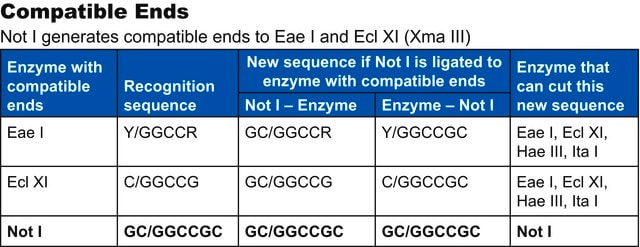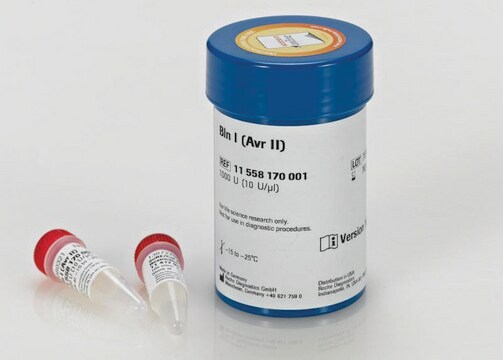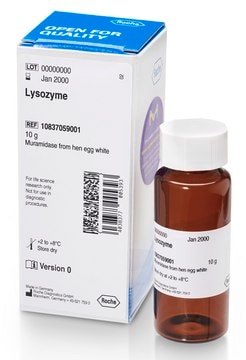SPEI-RO
Roche
Spe I
from Sphaerotilus species
Synonyme(s) :
Spe I, SPE I
About This Item
Produits recommandés
Source biologique
bacterial (Sphaerotilus spp.)
Niveau de qualité
Forme
solution
Activité spécifique
10000 U/mL
Conditionnement
pkg of 1,000 U (11008951001 [10 U/μl])
pkg of 1,000 U (11207644001 [40 U/μl])
pkg of 200 U (11008943001 [10 U/μl])
Fabricant/nom de marque
Roche
Paramètres
37 °C optimum reaction temp.
Couleur
colorless
pH
8.0 (39 °F)
Solubilité
water: miscible
Adéquation
suitable for molecular biology
Application(s)
life science and biopharma
sample preparation
Activité étrangère
Endonucleases 10 units, none detected
Conditions d'expédition
dry ice
Température de stockage
−20°C
Catégories apparentées
Description générale
Spécificité
*A*CTAGT
Restriction site: *A↓*CTAGT
*A↓*CTAGT
Heat inactivation: Spe I can be heat inactivated by incubation at 65 °C for 15 minutes (up to 100 U/μg DNA).
Qualité
1μg Ad2 DNA is incubated for 16 hours in 50μl SuRE/Cut Buffer H with an excess of Spe I. The number of enzyme units which do not change the enzyme-specific pattern is stated in the certificate of analysis.
Absence of exonuclease activity
Approximately 5μg [3H] labeled calf thymus DNA are incubated with 3μl Spe I for 4 hours at +37°C in a total volume of 100μl 50mM Tris-HCl, 10mM MgCl2, 1mM Dithioerythritol, pH approximately 7.5. Under these conditions, no release of radioactivity is detectable, as stated in the certificate of analysis.
Profil d'ADN
- λ: 0
- φX174: 0
- Ad2: 3
- M13mp7: 0
- pBR322: 0
- pBR328: 0
- pUC18: 0
- SV40: 0
Définition de l'unité
Stockage et stabilité
Remarque sur l'analyse
Spe I ends are compatible with ends generated by Bln I, Nhe I, and Xba I.
Isoschizomers
The enzyme is an isoschizomer of Bcu I and Ahl I.
Methylation sensitivity
As indicated by (*) on the recognition sequence above, Spe I is inhibited by the presence of N6-methyladenine and 5′-methylcytosine ( mA↓m CTAGT).
Incubation temperature
+37°C
PFGE tested
Spe I has been tested in Pulsed-Field Gel Electrophoresis (on bacterial chromosomes). For cleavage of genomic DNA (E. coli C 600) embedded in agarose for PFGE analysis, we recommend using 10U of enzyme/μg DNA and 4 hour incubation time.
Ligation and recutting assay
Spe I fragments obtained by complete digestion of 1μg Ad2 DNA are ligated with 1U T4 DNA Ligase in a volume of 10μl by incubation for 16 hours at +4°C in 66mM Tris-HCl, 5mM MgCl2, 5mM Dithiothreitol, 1mM ATP, pH 7.5 (at +20°C), resulting in >90% recovery of Ad2 DNA.
Subsequent re-cutting with Spe I yields >95% of the typical pattern of Ad2 × Spe I fragments.
The buffer in bold is recommended for optimal activity
- A: 75-100%
- B: 75-100%
- H: 100%
- L: 75-100%
- M: 100%
Autres remarques
Composants de kit seuls
- Enzyme Solution
- SuRE/Cut Buffer H 10x concentrated
Code de la classe de stockage
12 - Non Combustible Liquids
Classe de danger pour l'eau (WGK)
WGK 1
Point d'éclair (°F)
does not flash
Point d'éclair (°C)
does not flash
Certificats d'analyse (COA)
Recherchez un Certificats d'analyse (COA) en saisissant le numéro de lot du produit. Les numéros de lot figurent sur l'étiquette du produit après les mots "Lot" ou "Batch".
Déjà en possession de ce produit ?
Retrouvez la documentation relative aux produits que vous avez récemment achetés dans la Bibliothèque de documents.
Articles
The term “Restriction enzyme” originated from the studies of Enterobacteria phage λ (lambda phage) in the laboratories of Werner Arber and Matthew Meselson.
Contenu apparenté
Restriction endonucleases popularly referred to as restriction enzymes, are ubiquitously present in prokaryotes. The function of restriction endonucleases is mainly protection against foreign genetic material especially against bacteriophage DNA.
Notre équipe de scientifiques dispose d'une expérience dans tous les secteurs de la recherche, notamment en sciences de la vie, science des matériaux, synthèse chimique, chromatographie, analyse et dans de nombreux autres domaines..
Contacter notre Service technique






